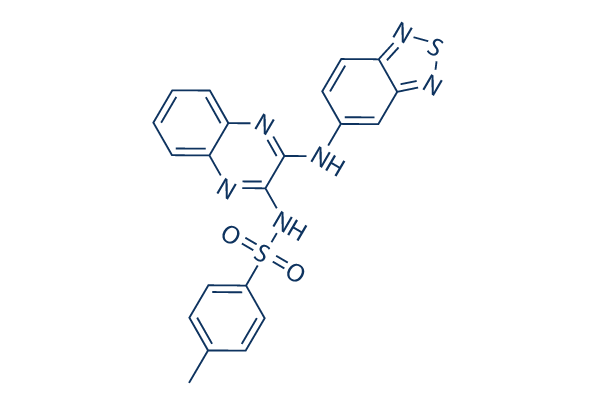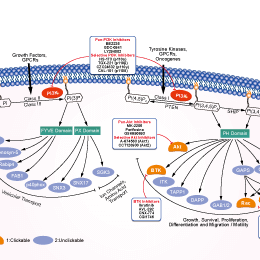
- Bioactive Compounds
- By Signaling Pathways
- PI3K/Akt/mTOR
- Epigenetics
- Methylation
- Immunology & Inflammation
- Protein Tyrosine Kinase
- Angiogenesis
- Apoptosis
- Autophagy
- ER stress & UPR
- JAK/STAT
- MAPK
- Cytoskeletal Signaling
- Cell Cycle
- TGF-beta/Smad
- DNA Damage/DNA Repair
- Compound Libraries
- Popular Compound Libraries
- Customize Library
- Clinical and FDA-approved Related
- Bioactive Compound Libraries
- Inhibitor Related
- Natural Product Related
- Metabolism Related
- Cell Death Related
- By Signaling Pathway
- By Disease
- Anti-infection and Antiviral Related
- Neuronal and Immunology Related
- Fragment and Covalent Related
- FDA-approved Drug Library
- FDA-approved & Passed Phase I Drug Library
- Preclinical/Clinical Compound Library
- Bioactive Compound Library-I
- Bioactive Compound Library-���
- Kinase Inhibitor Library
- Express-Pick Library
- Natural Product Library
- Human Endogenous Metabolite Compound Library
- Alkaloid Compound LibraryNew
- Angiogenesis Related compound Library
- Anti-Aging Compound Library
- Anti-alzheimer Disease Compound Library
- Antibiotics compound Library
- Anti-cancer Compound Library
- Anti-cancer Compound Library-���
- Anti-cancer Metabolism Compound Library
- Anti-Cardiovascular Disease Compound Library
- Anti-diabetic Compound Library
- Anti-infection Compound Library
- Antioxidant Compound Library
- Anti-parasitic Compound Library
- Antiviral Compound Library
- Apoptosis Compound Library
- Autophagy Compound Library
- Calcium Channel Blocker LibraryNew
- Cambridge Cancer Compound Library
- Carbohydrate Metabolism Compound LibraryNew
- Cell Cycle compound library
- CNS-Penetrant Compound Library
- Covalent Inhibitor Library
- Cytokine Inhibitor LibraryNew
- Cytoskeletal Signaling Pathway Compound Library
- DNA Damage/DNA Repair compound Library
- Drug-like Compound Library
- Endoplasmic Reticulum Stress Compound Library
- Epigenetics Compound Library
- Exosome Secretion Related Compound LibraryNew
- FDA-approved Anticancer Drug LibraryNew
- Ferroptosis Compound Library
- Flavonoid Compound Library
- Fragment Library
- Glutamine Metabolism Compound Library
- Glycolysis Compound Library
- GPCR Compound Library
- Gut Microbial Metabolite Library
- HIF-1 Signaling Pathway Compound Library
- Highly Selective Inhibitor Library
- Histone modification compound library
- HTS Library for Drug Discovery
- Human Hormone Related Compound LibraryNew
- Human Transcription Factor Compound LibraryNew
- Immunology/Inflammation Compound Library
- Inhibitor Library
- Ion Channel Ligand Library
- JAK/STAT compound library
- Lipid Metabolism Compound LibraryNew
- Macrocyclic Compound Library
- MAPK Inhibitor Library
- Medicine Food Homology Compound Library
- Metabolism Compound Library
- Methylation Compound Library
- Mouse Metabolite Compound LibraryNew
- Natural Organic Compound Library
- Neuronal Signaling Compound Library
- NF-��B Signaling Compound Library
- Nucleoside Analogue Library
- Obesity Compound Library
- Oxidative Stress Compound LibraryNew
- Plant Extract Library
- Phenotypic Screening Library
- PI3K/Akt Inhibitor Library
- Protease Inhibitor Library
- Protein-protein Interaction Inhibitor Library
- Pyroptosis Compound Library
- Small Molecule Immuno-Oncology Compound Library
- Mitochondria-Targeted Compound LibraryNew
- Stem Cell Differentiation Compound LibraryNew
- Stem Cell Signaling Compound Library
- Natural Phenol Compound LibraryNew
- Natural Terpenoid Compound LibraryNew
- TGF-beta/Smad compound library
- Traditional Chinese Medicine Library
- Tyrosine Kinase Inhibitor Library
- Ubiquitination Compound Library
-
Cherry Picking
You can personalize your library with chemicals from within Selleck's inventory. Build the right library for your research endeavors by choosing from compounds in all of our available libraries.
Please contact us at [email protected] to customize your library.
You could select:
- Antibodies
- Bioreagents
- qPCR
- 2x SYBR Green qPCR Master Mix
- 2x SYBR Green qPCR Master Mix(Low ROX)
- 2x SYBR Green qPCR Master Mix(High ROX)
- Protein Assay
- Protein A/G Magnetic Beads for IP
- Anti-Flag magnetic beads
- Anti-Flag Affinity Gel
- Anti-Myc magnetic beads
- Anti-HA magnetic beads
- Magnetic Separator
- Poly DYKDDDDK Tag Peptide lyophilized powder
- Protease Inhibitor Cocktail
- Protease Inhibitor Cocktail (EDTA-Free, 100X in DMSO)
- Phosphatase Inhibitor Cocktail (2 Tubes, 100X)
- Cell Biology
- Cell Counting Kit-8 (CCK-8)
- Animal Experiment
- Mouse Direct PCR Kit (For Genotyping)
- New Products
- Contact Us
XL147 analogue
Synonyms: SAR245408
XL147 analogue (SAR245408) is a selective and reversible class I PI3K inhibitor for PI3K��/��/�� with IC50 of 39 nM/36 nM/23 nM in cell-free assays, less potent to PI3K��. XL147 analogue induces apoptosis. Phase 1/2.

XL147 analogue Chemical Structure
CAS No. 956958-53-5
Purity & Quality Control
Batch:
Purity:
99.98%
99.98
XL147 analogue Related Products
Signaling Pathway
Biological Activity
| Description | XL147 analogue (SAR245408) is a selective and reversible class I PI3K inhibitor for PI3K��/��/�� with IC50 of 39 nM/36 nM/23 nM in cell-free assays, less potent to PI3K��. XL147 analogue induces apoptosis. Phase 1/2. | ||||||||
|---|---|---|---|---|---|---|---|---|---|
| Targets |
|
| In vitro | ||||
| In vitro | XL147 inhibits class I PI3K isoforms in an ATP-competitive manner. In a panel of HER2-overexpressing human breast cancer cell lines, treatment with XL147 abrogates AKT and S6 phosphorylation but also induces the expression and phosphorylation of HER3 and other RTKs. In HER2+ cells, phosphorylation of HER3 is maintained by the HER2 tyrosine kinase, leading to partial recovery of phosphorylated AKT (pAKT) and thereby limiting the antitumor action of XL 147. In addition, knockdown of HER3 or treatment with the anti-HER2 agents trastuzumab or lapatinib sensitizes HER2+ breast cancer cells to XL147 in vitro and in vivo. Treatment with XL147 inhibits the monolayer growth of all tested cell lines, including BT474, HCC1937 et al. in a dose-dependent manner. The main effect of XL147 is inhibition of cell proliferation. XL147 induces cell death at the concentration of 20 ��M. Treatment with XL147 leads to dose-dependent inhibition of PI3K. Consistent with the inhibition of cell proliferation, XL147 induces a reduction in cyclin D1 and pRB and an increase in levels of the CDK inhibitor p27KIPI but no detectable change in levels off total or cleaved poly (ADP-ribose) polymerase (PARP). Treatment with XL147 leads to a dose-dependent reduction in pAKTS473/T308 and pS6S240/244. Surprisingly, XL147 also triggers up-regulation of total HER3 and/or pHER3Y1289 levels. In HER2-overexpressing cells, inhibition of PI3K is followed by up-regulation of expression and phosphorylation of multiple receptor tyrosine kinases, including HER3. Knockdown of FoxO1 and FoxO3a transcription factors prevents the induction of HER3, InsR, IGF1R, and FGFR2 mRNAs upon inhibition of PI3K. In HER2+ cells, knockdown of HER3 with siRNA or cotreatment with the HER2 inhibitors trastuzumab or lapatinib enhances XL147-induced cell death and inhibition of pAKT and pS6. [2] | |||
|---|---|---|---|---|
| Cell Research | Cell lines | BT474 and HCC1937 cells | ||
| Concentrations | 0-20 ��M | |||
| Incubation Time | 72 hours | |||
| Method | Cells including BT474, HCC1937 et al. are seeded in 100-mm dishes in media containing 2.5% FBS with or without XL147. After 3 days, detached and adherent cells are pooled, ���xed, and labeled with propidium iodide by using the APO-BrdU kit. Labeled cells are analyzed using the Becton Dickinson FACSCalibur system. |
|||
| In Vivo | ||
| In vivo | Athymic mice with BT474 xenografts are randomly treated with XL147, lapatinib, trastuzumab, or XL147 plus each HER2 antagonist. Each monotherapy significantly inhibtis tumor growth with trastuzumab being the only agent that induced a complete tumor regression in one of eight mice. Both combinations are superior to the respective drugs given alone. Notably, the combination of trastuzumab and XL147, but not lapatinib and XL147, induces a complete tumor response in three of eight mice. There is no marked drug-related toxicity in any of the treatment arms. The combination of XL147 plus trastuzumab prevents pHER3 more potently than any of the other treatments. In good agreement with differences in tumor growth among treatment arms, nuclear pAKT is lower in tumors treated with XL147 plus lapatinib or XL147 plus trastuzumab compared with tumors treated with single agents. Of all three single drugs, XL147 is the only one shown statistically to repress nuclear pAKT levels. There are no detectable changes in cytoplasmic pAKT levels. Combined inhibition of HER2 and PI3K in HER2-dependent xenografts is required to maximally inhibit signaling output of the PI3K/AKT pathway. [2] | |
|---|---|---|
| Animal Research | Animal Models | Athymic female mouse bearing BT474 cells |
| Dosages | 100 mg/kg | |
| Administration | Orogastric gavage | |
| NCT Number | Recruitment | Conditions | Sponsor/Collaborators | Start Date | Phases |
|---|---|---|---|---|---|
| NCT01943838 | Completed | Neoplasm Malignant |
Sanofi |
October 2013 | Phase 1 |
| NCT01436565 | Completed | Solid Tumor Cancers |
Sanofi|Merrimack Pharmaceuticals |
November 2011 | Phase 1 |
| NCT01392924 | Completed | Neoplasm Malignant |
Sanofi |
August 2011 | Phase 1 |
| NCT01357330 | Completed | Solid Tumors |
Sanofi |
May 2011 | Phase 1 |
| NCT01240460 | Completed | Glioblastoma|Astrocytoma Grade IV |
Sanofi |
January 2011 | Phase 1 |
Chemical Information & Solubility
| Molecular Weight | 448.52 | Formula | C21H16N6O2S2 |
| CAS No. | 956958-53-5 | SDF | Download XL147 analogue SDF |
| Smiles | CC1=CC=C(C=C1)S(=O)(=O)NC2=NC3=CC=CC=C3N=C2NC4=CC5=NSN=C5C=C4 | ||
| Storage (From the date of receipt) | |||
|
In vitro |
DMSO : 3 mg/mL ( (6.68 mM) Moisture-absorbing DMSO reduces solubility. Please use fresh DMSO.) Water : Insoluble Ethanol : Insoluble |
Molecular Weight Calculator |
|
In vivo Add solvents to the product individually and in order. |
In vivo Formulation Calculator |
||||
Preparing Stock Solutions
Molarity Calculator
In vivo Formulation Calculator (Clear solution)
Step 1: Enter information below (Recommended: An additional animal making an allowance for loss during the experiment)
mg/kg
g
��L
Step 2: Enter the in vivo formulation (This is only the calculator, not formulation. Please contact us first if there is no in vivo formulation at the solubility Section.)
% DMSO
%
% Tween 80
% ddH2O
%DMSO
%
Calculation results:
Working concentration: mg/ml;
Method for preparing DMSO master liquid: mg drug pre-dissolved in ��L DMSO ( Master liquid concentration mg/mL, Please contact us first if the concentration exceeds the DMSO solubility of the batch of drug. )
Method for preparing in vivo formulation: Take ��L DMSO master liquid, next add��L PEG300, mix and clarify, next add��L Tween 80, mix and clarify, next add ��L ddH2O, mix and clarify.
Method for preparing in vivo formulation: Take ��L DMSO master liquid, next add ��L Corn oil, mix and clarify.
Note: 1. Please make sure the liquid is clear before adding the next solvent.
2. Be sure to add the solvent(s) in order. You must ensure that the solution obtained, in the previous addition, is a clear solution before proceeding to add the next solvent. Physical methods such
as vortex, ultrasound or hot water bath can be used to aid dissolving.
Tech Support
Answers to questions you may have can be found in the inhibitor handling instructions. Topics include how to prepare stock solutions, how to store inhibitors, and issues that need special attention for cell-based assays and animal experiments.
Tel: +1-832-582-8158 Ext:3
If you have any other enquiries, please leave a message.
* Indicates a Required Field
Tags: buy XL147 analogue | XL147 analogue supplier | purchase XL147 analogue | XL147 analogue cost | XL147 analogue manufacturer | order XL147 analogue | XL147 analogue distributor







































